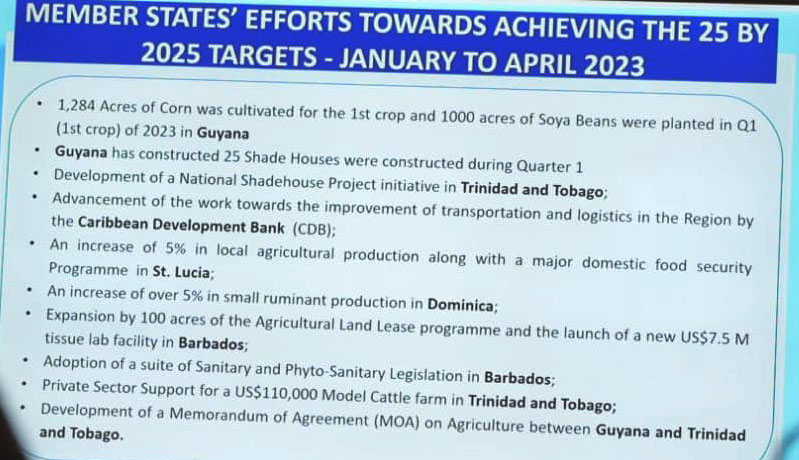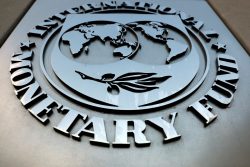President Irfaan Ali says that there is a “real possibility” that CARICOM will achieve its ambitious goal of reducing the region’s food importation bill by 25 percent by 2025.
He was speaking at Wednesday’s press conference in Trinidad and Tobago to mark the end of the CARICOM Heads of Government Meeting which coincided with the 50th anniversary of the founding of the regional integration movement.
In response to a question from Stabroek News, Ali said that “Based on our original targets we are doing well and I believe we now have the real possibility of meeting those targets.”
Ali is the Lead Head of Government with responsibility for agriculture in the CARICOM Quasi Cabinet.
There have been growing questions as to whether CARICOM will meet its hefty goal of cutting imports by a quarter with just 18 more months to go.
Ali had, in March 2022, presented an agricultural development plan at CARICOM’s Heads of Government meeting. The plan’s implementation was expected to be swift, with the involvement of all relevant stakeholders. Ali was requested to mandate the Ministerial Task Force [MTF] on Food Security to propose an implementation schedule for urgent consideration by Heads of Government.
Questioned on Wednes-day about how realistic the 25 by 2025 deadline was for the region’s reduction on its food imports objective and on progress made by individual countries, Ali responded by saying that a momentum is being built by encouraging investments from both governments and private sector. He disclosed that in Trinidad and Tobago, preparations are afoot for 3,000 acres of rice cultivation and that seed paddy was already distributed to farmers. He referred to a prawn farm currently being set up in Barbados and St Lucia’s push for diversification of agriculture. “In every single country, you are seeing more investment, more interest, and more dynamism! This is going in the right direction,” Ali declared.
He added that throughout the region, they are “looking to use technology, hydroponics, and aquaculture and [cultivating] high yielding crops…” as a part of a holistic and integrated plan to achieve the 25/25 goal.
The President added that there are, simultaneously, engagements in research and development to determine achievable rates of returns which will be offered to prospective investors. He noted that each country has their own self-imposed targets they are working to achieve and they are exploring other means to tackle trade barriers. But while there is a great push for production, Ali pointed out that there are changing circumstances and new challenges. He explained that the region is lacking in storage capacity and this is a new area identified for investment by the private sector. Using poultry feed as an example, he said the region currently has only 20 percent storage capacity for all of the grains needed to feed poultry for the region’s consumption.
“In terms of the food production, I believe we have to be real, the circumstances around us is changing every single day and there are some structural and institutional problems that we are resolving”, he told the press conference.
In February 2023, the MTF issued a release announcing that member states combined were able to achieve 57% of the targets set. According to the data, products such as cocoa reached 96.13%, dairy 84.36%, meat 72.28%, root crops 70.91%, fruits 70.77%, and poultry 70.19%, of the targeted production volume set for the year 2025. The release added that the update followed each country’s report detailing their production data submitted for 2022. The MTF report pointed out that countries such as Barba-dos, Belize, Dominica, Guyana, Jamaica, St. Vin-cent and the Grenadines, Suriname and Trinidad and Tobago, all made “significant advances” in the production of ginger, turmeric, corn, cocoa, dairy, fish, fruits, meat, poultry, root crops, soya bean, and table eggs. It said that for 2022, Guyana produced 20,195 metric tonnes of ginger and turmeric, 144,289 metric tonnes of root crops, 21,870 metric tonnes of fish, and 40,749 metric tonnes of coconut. In addition to member states’ updates on production targets, attendees were briefed on several other notable achievements.
The release also noted that during the 104th Special Meeting of the Council for Trade and Economic Development (COTED), trade policies for Animal and Animal Products, a Regional Agricultural Health and Food Safety Policy, Spe-cial Sanitary and Phyto-sanitary (SPS) guidelines for 19 commodities, and alternative SPS settlement mechanisms were approv-ed. Guyana’s Agriculture Minister, Zulfikar Mustapha, who chairs the MTF, said that these were great achievements for the Taskforce. He posited that with these mechanisms in place, a level playing field was created to ease intra-regional agricultural trade. “These [four] achievements are testimony to the hard work of the MTF. If we are allowed to increase intra-regional trade, we will be well on the way to reducing the regional food import bill, which is the ultimate goal of CARICOM in keeping with its food security agenda. In just one year, collaborative efforts among member states have yielded much success,” he was quoted as saying.
Several priority areas have been identified for 2023 including agriculture insurance and financing, trade and E-agriculture, resource mobilisation, and trade support. According to Mustapha, these will help to advance the MTF and CARICOM’s efforts to achieve its ‘Vision 25 by 2025’.










